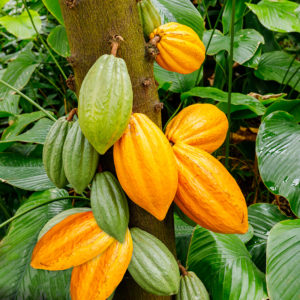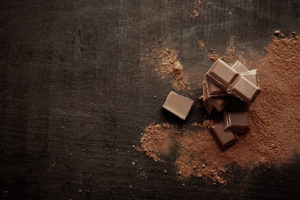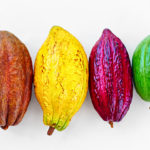Chocolate: What’s in a Word?
By Susan Parsley
 Chocolate – cocoa – cacao. Chocolate is a superfood that has strengthened the body and soul for many different cultures throughout the world. The words “cacao” and “cocoa” are often used synonymously. Cacao is a tree, which produces football-sized pods called “cacao pods.” Within these pods is a creamy white substance, the seed of the theobroma or cacao tree. Cocoa beans are the source of cocoa powder. Chocolate bars, cacao nibs (ground up cocoa beans), candy, desserts, teas and everything else “chocolate” begins with these delectable, yet bitter, seeds.
Chocolate – cocoa – cacao. Chocolate is a superfood that has strengthened the body and soul for many different cultures throughout the world. The words “cacao” and “cocoa” are often used synonymously. Cacao is a tree, which produces football-sized pods called “cacao pods.” Within these pods is a creamy white substance, the seed of the theobroma or cacao tree. Cocoa beans are the source of cocoa powder. Chocolate bars, cacao nibs (ground up cocoa beans), candy, desserts, teas and everything else “chocolate” begins with these delectable, yet bitter, seeds.
Chocolate originated in Mesoamerica. During the time of the Olmec, Mayan and Aztec empires, cocoa beans were valued so highly that they were used as currency. One bean would buy a pumpkin and ten beans a rabbit. Cocoa was also a frothed drink made from crushed beans and flavored with spices. It was regarded as a luxury and an elite medicinal drink.
Since cacao trees are equatorial, Europeans were unfamiliar with cacao and its health benefits until Columbus, and later the conquistador Cortez explored the new world. After the Aztec were conquered by Cortez, and the population was diminished by smallpox, missionary nuns came to the new world and began the transformation of chocolate into a sweet delicacy when they added sugar to reduce the bitterness of the chocolate drink.
Upon arrival in Spain, this sugared chocolate drink swept across Europe. In England, the first chocolate house opened in 1657. This men’s social club served chocolate as a refreshing drink with health benefits.
Chocolate remained a beverage until the Englishman Joseph Frey and sons created the first chocolate bar in 1847. As the chocolate craze continued, more sugar, milk, vanilla, and other ingredients were added to minimize the bitterness of chocolate. These additives and the practice of over-roasting beans removed many health benefits of cacao. Thus, in the 1800’s, chocolate became synonymous with candy rather than the superfood it is.
Modern day cacao is grown in Peru, Dominican Republic, Mexico, Ecuador, Vietnam, Brazil, Ghana, Madagascar, Haiti, India, Guatemala, and other countries.
Manufacturing cocoa beans into chocolate candy involves harvesting, fermenting, drying, roasting, cracking and winnowing (removing the thin shell), followed by grinding, conching (creates a smooth texture) and tempering (prevents “bloom,” the light coating occurring when chocolate gets too warm). The roasting time is determined by the quality of the bean being processed. Roasting brings out the flavor of the cocoa bean and removes the natural bitterness at the expense of many of the over 4500 antioxidants and polyphenols cocoa beans contain. Raw cacao is minimally processed, thus retaining most of its nutrients.
Before purchasing that yummy chocolate delicacy, you need more information to help make your selection. There are three classifications of cacao: forestero, crillo, and trinitario. Forestero is most commonly grown and produced. It is disease-resistant and represents 85% of the world’s chocolate production. Because of its low quality and extreme bitterness, chocolatiers tend to over-roast the beans and add excessive amounts of vanilla and sugar to make it palatable. (There are a few exceptions, such as the arriba nacional forestero bean grown in Equador, which represents about 5% of the cocoa bean market).
Criollo (Cree-yo-yo) is the heirloom cacao. Representing 1-5 % of the world’s chocolate production, chocolate makers add only a small amount of sugar and possibly vanilla to produce these bars. Unfortunately, the quality is reflected in the price you will pay. These bars generally have a minimum of 70% cacao and contain 5 ingredients or less. Many have 2 ingredients, cacao and sugar, meaning the bar contains 70% cacao and 30% sugar. The flavor of these exquisite bars comes from the soil where the cacao tree is grown. Bars from Madagascar tend to be fruity and floral, while bars from Djarta, Indonesia (which contain the same 2 ingredients), have leathery or smoky flavor tones.
Trinitario is a hybrid of criollo and forestero. In Trinidad, the criollo crop was threatened with extinction due to disease. A local farmer grafted a forestero branch onto the diseased criollo tree. The resulting tree was named trinitario. This cacao retains much of the criollo smoothness; but, is hardier than the criollo tree.
General guidelines for a bar to be considered chocolate require 5 ingredients or less with a 70% cacao minimum. The remaining ingredients can be cocoa butter, sugar, vanilla and/or soy lecithin. The preferred chocolate bar only has two ingredients, cacao, and sugar.

Chocolate’s health benefits are significant. The U.S. Department of Agriculture and the Journal of American Chemical Society say dark chocolate contains 13,120 units on the ORAC (Oxygen Radical Absorbance Capacity) scale per 100 grams. Chocolate contains many different nutrients including magnesium, iron, copper, phosphorous, potassium, fiber, zinc, manganese, selenium, and fatty acids. But BEWARE! What many consider chocolate is actually chocolate candy. To receive the nutritional benefits of chocolate, you need chocolate, not chocolate candy. The best nutritional source is raw cocoa. The best tasting raw cocoa is criollo. Most prefer roasted cocoa beans over raw beans. For the health-conscious on a budget, there are many chocolate candy bars on the market processed with better nutritional additives than sugar and artificial ingredients. Remember: no matter which bar you choose, the less-expensive bars are made from the bitter forestero and contain more additives than trinitario and criollo.
A “single origin” bar is a chocolate bar made from beans from one source. The name of the bar, for example, “Chuao”, “Madagascar”, or “Djkarta” indicate the source of the beans in that bar. If the bar isn’t “single origin,” then it’s from multiple sources and you will not know the bean source or classification. Grocery/department stores do not usually carry premium chocolate. Lower quality bars are less than $5.00, usually $1.00-$3.00.
Chocolate bars should be savored like fine wines. Place a small piece in your mouth. Chew a few times then let it melt on your tongue to experience the flavor tones. It can be magnificent! A small piece usually satisfies a craving, so chocolate bars, while more expensive, are economical.
Chocolate is a superfood that can strengthen your body and soul. Before enjoying this delectable and delightful delicacy, always read the label.
Susan Parsley, BME, CHC, AADP
 Susan Parsley is a certified integrative health coach and piano teacher whose passion is sharing her knowledge with others to help create their best health. She received her health coaching certification from the Institute for Integrative Nutrition in NYC, NY in 2014 and her Bachelor of Music Education/Area degree from Butler University in Indianapolis, Indiana in 1980. In 2015, she attended chocolate classes in Salt Lake City, Utah in order to teach chocolate lovers how to enjoy chocolate in a healthy and tasty way. She is the owner of Sprouting New Life Health Coaching Services and Harmonic Hands Piano Studio. She can be contacted at 785-320-5041 or personal message her at www.facebook.com/sproutingnewlife. You can email her at coachsusanparsley@gmail.com.
Susan Parsley is a certified integrative health coach and piano teacher whose passion is sharing her knowledge with others to help create their best health. She received her health coaching certification from the Institute for Integrative Nutrition in NYC, NY in 2014 and her Bachelor of Music Education/Area degree from Butler University in Indianapolis, Indiana in 1980. In 2015, she attended chocolate classes in Salt Lake City, Utah in order to teach chocolate lovers how to enjoy chocolate in a healthy and tasty way. She is the owner of Sprouting New Life Health Coaching Services and Harmonic Hands Piano Studio. She can be contacted at 785-320-5041 or personal message her at www.facebook.com/sproutingnewlife. You can email her at coachsusanparsley@gmail.com.
Chocolate Trivia
- Chocolatier- a person who makes chocolate candy
- Chocolate maker- a person who makes chocolate
- Chocolate is good for the heart both mentally and physically.
- Chocolate causes the brain to release serotonin, dopamine, and endorphins.
- “Hot cocoa” is a thin, sweetened chocolate beverage made from cocoa powder, sugar and milk. “Hot chocolate” is made from chocolate pieces, shaved or ground for quick melting and is thick, less sweet and tends to be more rich tasting.
- Chocolate comes from cocoa seeds which come from cacao pods which grow on Theobroma trees meaning “food of the gods”.
- The shell of the cocoa bean has a higher concentration of antioxidants than the softer center.
- Cacao nibs are crushed cocoa beans and are delicious sprinkled on fresh berries.
- Raw cacao contains over 4500 antioxidants.
Cocoa Peppermint Smoothie
- 12 oz non-dairy milk
- 1 T coconut oil or MCT oil
- ¼ tsp vanilla
- 1 tsp raw honey
- 2 drops peppermint essential oil* OR ( ½ tsp peppermint extract)
- 1 T cocoa powder (or to taste)*
- 1 scoop collagen protein
- 1 scoop Vitamin C powder such as Vitality C or Bio En’R-G’y C
If desired, add water and ice for desired consistency
Combine all ingredients and blend until smooth.
Note: This smoothie can be made without a blender. Mix the powders together. Fill a 12 oz glass half full with milk. Use a frother to mix the powder into the milk. Add the remaining ingredients and then fill the glass with milk. Enjoy!
*You can reduce the amount of cocoa powder and peppermint according to your taste preference.





